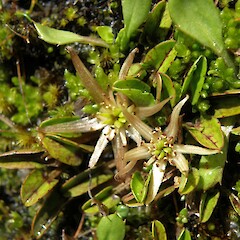Caltha novae-zelandiae
Common name
New Zealand marsh marigold, yellow caltha
Synonyms
Psychrophila novae-zelandiae (Hook.f.) W.A.Weber
Family
Ranunculaceae
Flora category
Vascular – Native
Endemic taxon
Yes
Endemic genus
No
Endemic family
No
Structural class
Herbs - Dicotyledons other than Composites
NVS code
The National Vegetation Survey (NVS) Databank is a physical archive and electronic databank containing records of over 94,000 vegetation survey plots - including data from over 19,000 permanent plots. NVS maintains a standard set of species code abbreviations that correspond to standard scientific plant names from the Ngä Tipu o Aotearoa - New Zealand Plants database.
CALNOV
Chromosome number
2n = 48
Current conservation status
The conservation status of all known New Zealand vascular plant taxa at the rank of species and below were reassessed in 2017 using the New Zealand Threat Classification System (NZTCS) – more information about this can be found on the NZTCS website. This report includes a statistical summary and brief notes on changes since 2012 and replaces all previous NZTCS lists for vascular plants.
Please note, threat classifications are often suggested by authors when publications fall between NZTCS assessment periods – an interim threat classification status has not been assessed by the NZTCS panel.
- Conservation status of New Zealand indigenous vascular plants, 2017 . 2018. Peter J. de Lange, Jeremy R. Rolfe, John W. Barkla, Shannel P. Courtney, Paul D. Champion, Leon R. Perrie, Sarah M. Beadel, Kerry A. Ford, Ilse Breitwieser, Ines Schönberger, Rowan Hindmarsh-Walls, Peter B. Heenan and Kate Ladley. Department of Conservation. Source: NZTCS and licensed by DOC for reuse under the Creative Commons Attribution 4.0 International licence.
2017 | Not Threatened
Previous conservation statuses
2012 | Not Threatened
2009 | Not Threatened
2004 | Not Threatened
Distribution
Endemic. North, South and Stewart Islands from the main axial ranges of the North Island south.
Habitat
Montane to alpine. Mostly in alpine flushes, seepages, around tarns and slow flowing streams. Also found seen in damp areas in open grassland and in similar sites in fellfield and herbfield.
Wetland plant indicator status rating
Information derived from the revised national wetland plant list prepared to assist councils in delineating and monitoring wetlands (Clarkson et al., 2021 Manaaki Whenua – Landcare Research Contract Report LC3975 for Hawke’s Bay Regional Council). The national plant list categorises plants by the extent to which they are found in wetlands and not ‘drylands’. The indicator status ratings are OBL (obligate wetland), FACW (facultative wetland), FAC (facultative), FACU (facultative upland), and UPL (obligate upland). If you have suggestions for the Wetland Indicator Status Rating, please contact: [Enable JavaScript to view protected content]
OBL: Obligate Wetland
Almost always is a hydrophyte, rarely in uplands (non-wetlands).
Detailed description
Glabrous, rhizomatous perennial of alpine flushes, seepages, bogs and stream sides. Plants forming a low turf with scapes 30-50(-180 mm) tall. Rhizomes stout, white, fleshy. Leaves radical, clustered; petiole up to 100 mm long, slender, grooved, expanded to form a membranous sheathing base. Lamina 8-25 × 4-12 mm, dark green (sometimes centrally blotched and/or marked with bronze), ovate-oblong to oblong, base 2-lobed, subcordate, apex deeply emarginate; margins slightly sinuate to entire; lobes upturned and ± appressed to lamina, almost to midsection of lamina. Scape solitary, short, 1-flowered, finally up to 180 mm long. Sepals 5-7, 10.0-30.0 × 1.8-3.0 mm, pale yellow, 3-nerved, linear-subulate, attenuate. Stamens 15-20; carpels 6-12, ovate in outline, 4-5 mm long; style stout, c.2 mm long. Ripe heads 12-18 mm diameter. Seeds 2-5 per follicle, 1.2- 2.0 mm long, glossy red-brown to dark purple brown, ovate to broadly ovate, or elliptic ovate.
Similar taxa
Only reliably distinguished from other, small, alpine Ranunculus when flowering. From Caltha obtusa readily distinguished when flowering by the linear-subulate yellow rather than oblong-obovate white flowers, and vegetatively by the leaf margins which are shallowly sinuate to entire rather than crenate. Both C. obtusa and C. novae-zelandiae are easily distinguished from the uncommon, naturalised marsh marigold (C. palustris) by their much smaller size, turf-forming growth habit, ecology, and features of the foliage and flowers.
Flowering
September - December
Flower colours
Yellow
Fruiting
December - March
Propagation technique
Difficult. Can be grown in a pot but needs to be kept moist, free of bryophytes and algal growth. Needs plenty of light but resents high temperatures and humidity
Etymology
caltha: From the Greek kalathos ‘goblet’, refers to the form of the flower
novae-zelandiae: Of New Zealand
Where To Buy
Not commercially available.
Taxonomic Notes
New Zealand plants had long been placed in the genus Caltha, they were then referred to Psychrophila, a decision which was over-ruled on the basis of a detailed study by Schuettpelz & Hoot (2004).
Attribution
Factsheet prepared for NZPCN by P.J. de Lange (28 March 2012). Description by P.J. de Lange.
References and further reading
Schuettpelz, E.; Hoot, S.B. 2004: Phylogeny and biogeography of Caltha (Ranunculaceae) based on chlroroplast and nuclear DNA sequences. American Journal of Botany 91(2): 247-253.
NZPCN Fact Sheet citation
Please cite as: de Lange, P.J. (Year at time of access): Caltha novae-zelandiae Fact Sheet (content continuously updated). New Zealand Plant Conservation Network. https://www.nzpcn.org.nz/flora/species/caltha-novae-zelandiae/ (Date website was queried)









